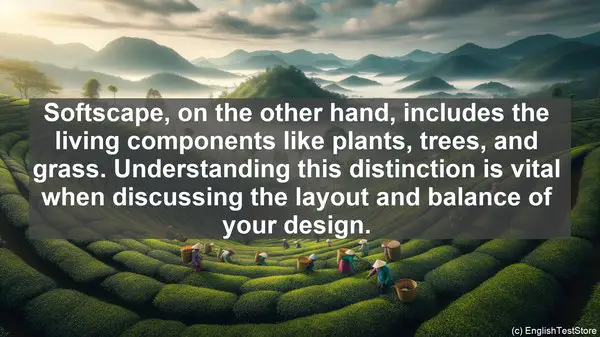1. Hardscape vs. Softscape
Many people mistake hardscape for softscape and vice versa. Hardscape refers to the non-living elements in a landscape, such as pathways, walls, and structures. Softscape, on the other hand, includes the living components like plants, trees, and grass. Understanding this distinction is vital when discussing the layout and balance of your design.

2. Annual vs. Perennial
Annual plants complete their life cycle within a year, while perennials regrow every year. When planning your garden, consider the longevity and maintenance requirements of each. Annuals offer vibrant colors but need replanting, while perennials provide a more consistent presence.
3. Xeriscape vs. Oasis
Xeriscape and oasis represent two contrasting approaches to landscaping. Xeriscaping focuses on water conservation, using drought-tolerant plants and efficient irrigation. An oasis, on the other hand, is a lush, water-rich environment. The choice depends on factors like climate, resources, and personal preferences.

4. Fertilizer vs. Pesticide
While both are used in plant care, fertilizers and pesticides have distinct roles. Fertilizers provide essential nutrients for growth, while pesticides control pests and diseases. It’s crucial to identify the specific issue and choose the appropriate solution to avoid unintended consequences.
5. Native vs. Exotic
Native plants are indigenous to a particular region, while exotics come from elsewhere. Each has its benefits and considerations. Native plants are well-adapted to the local environment, requiring less maintenance. Exotics can offer unique aesthetics but may need more attention and resources.
6. Pruning vs. Shearing
Pruning and shearing are both techniques to shape and maintain plants, but they differ in approach. Pruning involves selectively removing specific branches or stems to enhance structure and health. Shearing, on the other hand, is a more uniform trimming, often used for hedges or topiaries.
7. Mulch vs. Compost
Mulch and compost are valuable additions to soil, but they serve different purposes. Mulch is a protective layer on the soil surface, conserving moisture and suppressing weeds. Compost, on the other hand, is a nutrient-rich organic matter that improves soil fertility. Both have their roles in a healthy garden.
8. Accent vs. Focal Point
In design, accents and focal points create visual interest. An accent is a smaller element that draws attention, like a unique plant or sculpture. A focal point, on the other hand, is a more prominent feature, such as a grand tree or a water feature. Both contribute to the overall aesthetics and balance.
9. Evergreen vs. Deciduous
Evergreen and deciduous refer to the foliage of plants. Evergreens retain their leaves year-round, providing consistent color and texture. Deciduous plants shed their leaves in the fall, often with vibrant displays. The choice depends on factors like desired seasonal variation and maintenance preferences.
